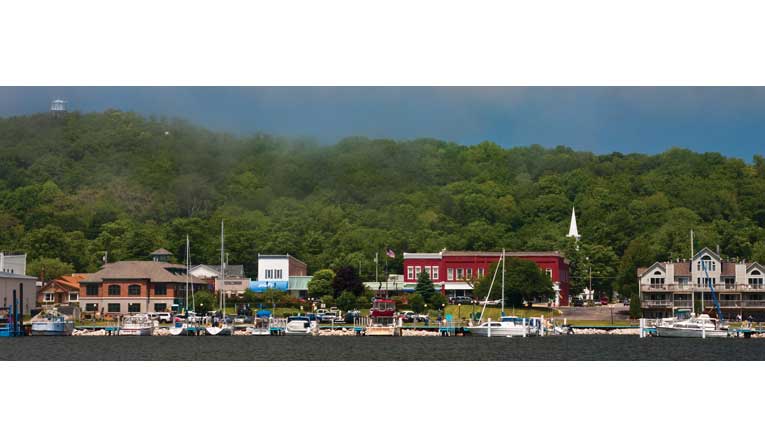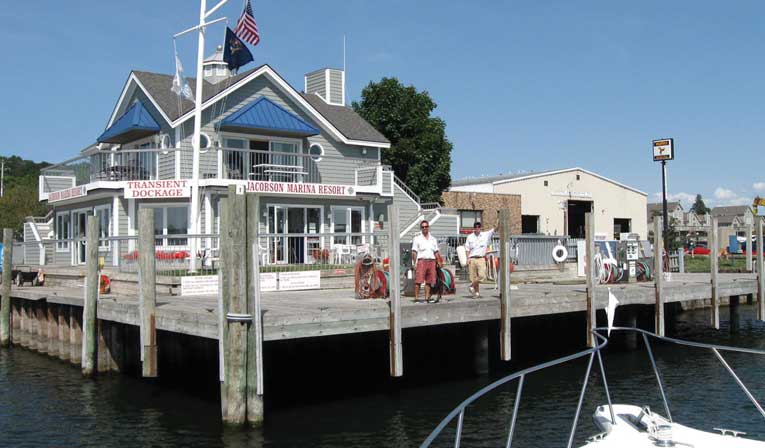Photo by Jim Sorbie
List the ingredients for a quintessential beach vacation and chances are Benzie County, Michigan, has them covered: Sand perfect for lounging or strolls, rivers, festivals, trails, fresh-caught fish, craft beer — and more.
For some 38 years, Ronn Beyette has worked at or around the entrance to the Frankfort, Michigan, harbor as a charter fishing captain, yacht captain and harbormaster. He’s seen more than a thousand sunsets over the Frankfort breakwater lighthouse, caught steelhead and trout, and watched bald eagles swoop over the bay. He was even around when a History Channel crew searched for gold bars that may (or may not) lie at the bottom of the harbor in rail cars. That search will be featured in the upcoming season of “The Curse of Civil War Gold.”
The harbor was once a commercial center when railroad cars and passenger steamships ferried to and from this port, Beyette notes, and while its draw is more recreational than commercial now, it’s still a boating destination that’s hard to top. It’s also a treasure by any definition.
“The thing about Frankfort is it’s a deepwater port and the proximity of the marina to the city is perfect,” Beyette says. “Boaters can walk to restaurants, the beach and other businesses.”

Photo Courtesy of Make It Benzie
Festival Fun
 Summer kicks off with a cookout at the annual Beer & Brat Festival at Crystal Mountain during Memorial Day weekend. There’s also slope-side entertainment at the region’s four-season resort and ample samplings from the state’s top microbreweries.
Summer kicks off with a cookout at the annual Beer & Brat Festival at Crystal Mountain during Memorial Day weekend. There’s also slope-side entertainment at the region’s four-season resort and ample samplings from the state’s top microbreweries.
Come summer, the Frankfort Art Fair (this year August 16 – 17) features the juried works of more than 100 artists.
Early fall brings the salmon run and the Coho Salmon Festival. The festival’s home, Honor, is where the state first stocked the popular sport fish.
Stick around or make a return visit to see the giant carved pumpkins displayed (and sometimes jettisoned into the bay) at the Frankfort Fall Festival (October 12), where there are also special floats, a “mutt march,” beer and mead tastings, wagon rides through town and more. The kid-friendly Beulah Fall Festival (October 5) is held the weekend before and the Frankfort Beer Week is held the week between the two.
And when the bay freezes, things really get fun. Head to Beulah’s annual Winterfest in February, and once you’ve finished your chili tasting and horse-drawn wagon rides, you can join the “Outhouse Sprint” and more.
Photo Courtesy Beer & Brat Facebook
Photo Courtesy of Michigan Municipal League
A harbor with a past
If you’d have fixed a History Channel camera on the harbor throughout the decades, you would have captured the heart of Victorian-era tourism history and the rise of industries from lumber to automobiles to commercial fishing. Railroad companies of the day picked Frankfort as the first port to house car ferries that would haul goods across Lake Michigan to Wisconsin. Historic photos show sometimes five car ferries operating in the harbor at any one time. The ferries would bring raw materials from Lake Superior ports across the lake, Beyette says, and ferry back finished automobiles made in Detroit, bound for points west.
Trains and ships also brought tourists. The Ann Arbor Railroad Company built both Mackinac Island’s Grand Hotel and Frankfort’s Royal Frontenac Hotel. Located at the spot of what’s today the beachfront Harbor Lights Resort, historic documents describe the Royal Frontenac Hotel operating from 1902 to 1912 as being built “for the sole purpose of popularizing beautiful Frankfort.” Documentation claimed that “no attraction and accommodation that money, skill and ingenuity could provide would be omitted.”
The 500-foot, 200-room hotel would later boast telephones (rare in the day) in every room, a cigar and candy store on site, a game room and even slot machines. Passengers arriving by boat from Chicago, St. Louis or Milwaukee, or rail from elsewhere in the south and Midwest, would be indulged and entertained with boat excursions, swimming classes and horseback riding lessons.
The feel of early resort life continues across Benzie County in a few resort complexes like the circa-1930s Chimney Corners Resort on nearby Crystal Lake, notable for its clear, often turquoise waters. Rent a lodge room or breezy hillside cottage, or experience it through events like the Wednesday barbecue, at which owner Jim Rogers works as pit boss grilling ribs, chicken, burgers and brats.
The closest marina to Lake Michigan is The Marina at Harbor Lights, uniquely positioned at the west end of the Frankfort harbor. This marina is less than a block from the beach and downtown attractions, and offers upscale amenities, including an indoor pool and hot tub. The Marina at Harbor Lights offers transient and seasonal slip rentals, as well as slips for sale.
Boaters who dock at one of the other half-dozen marinas (like the Frankfort Municipal Marina and the other private marinas, including Jacobson Marina Resort) situated on Betsie Lake can experience life akin to those early visitors who came without vehicles. The walk into town today, though, is to art galleries, restaurants and microbreweries.
You won’t doubt the importance of the harbor once locals give directions, generally given relative to the Lake Michigan beach. In block one, find the kiosk of Crystal Lake Adventure Sports and rent a bike, kayak or paddleboard for playing on Lake Michigan or Crystal Lake. Also in that first block is the start of the Betsie Valley Trail, a paved 9.7-mile route from Frankfort to Beulah by way of Elberta (notable for a bluff-lined beach) and several woodsy crossings of the Crystal River. Beulah has a small municipal beach on Crystal Lake and also the Cherry Hut, a must-stop for the vintage “Cherry Jerry” sign and a memorable slice of homemade cherry pie.
In block two, find the partner businesses of Stormcloud Brewing Company and the circa 1923 Garden Theater. At Stormcloud, sample a brew like “The Farthest Shore” Belgian dark ale; at Garden, find flicks making the international film fest circuit. In the winter, there are curling lessons in an alley between the two.
The ship-themed restaurant Dinghy’s holds fish frys on Friday and Saturday nights, and at block 11, you can have your own fresh-catch smoked (or buy someone else’s catch, fresh or made into take-out sandwiches) at the Port City Smokehouse.
En route, browse shops, like the Focus Galley showcasing landscape photography by Drew Smith. You can see other local artists at the Elizabeth Lane Oliver Center for the Arts in a restored Coast Guard station.

Photo Courtesy of Jacobson Marina Resort
On wheels
You don’t need a car (but you may want one) to explore some of the region’s other iconic attractions, including the roadways themselves. One of the state’s few restored drive-in movie theaters is The Cherry Bowl along Highway 31 near Honor. Vintage cartoons are the opening act — just as they were in the 1950s — and there’s popcorn with real butter to be enjoyed during the family friendly double features under the stars.
Then there’s M-22. USA Today named the drive stretching from Manistee to Leelanau County (and running the length of Benzie) America’s most scenic fall drive. Take it south to the county’s southern edge to find Inspiration Point or Arcadia Overlook, then climb the 120 steps to a panoramic view of Lake Michigan’s coastline. Mystery awaits at “Gravity Hill,” at Joyfield and Putney Roads by the Blaine Christian Church, where you’ll swear your car rolls backwards uphill. You’ll be mystified in a good way at your final stop, Iron Fish Distillery, in Thompsonville. In the lively barn pub setting, sample barrel-finished gin and more on the state’s first working farm devoted to small-batch craft spirits.
Inland to Thompsonville, four-season Crystal Mountain offers a destination spa, golf course, skiing hills and a chance to explore the Michigan Legacy Art Park, a 50-sculpture gallery all with a Michigan theme and set within a stunning forest.
For an especially private day at the beach, head to the county’s northernmost tip where winding Otter Creek meets Lake Michigan within the Sleeping Bear Dunes National Lakeshore. This now-sandy beach inlet was once the town of Aral, which was named when early settlers thought it was as stunning as Europe’s Aral Sea. An interpretive sign tells the story of a ghost town that once held a sawmill, company store, schoolhouse and even a schooner band that liked to entertain beach-goers.
History and Mystery
For more history fun, the Benzie Area Historical Museum displays artifacts related to the county’s past. The tales are also shared in abbreviated form at historic markers around the county. One located at the Benzonia Public Library on U.S. 31 (near the museum) celebrates Pulitzer Prize-winning author and historian Bruce Catton and the way his Civil War fascination started in Benzonia, where his father was a teacher and principal at Benzonia Academy. The Civil War veterans he grew up with “gave a color and a tone” to patriotism, freedom and progress, the marker notes; Catton wrote “Waiting for the Morning Rain” about his Michigan boyhood.
Few things are as controversial as the death spot of beloved explorer and missionary Father Jacques Marquette. A marker overlooking Betsie Bay Harbor draws on evidence from the 1960s to claim his death site near the natural outlet of Betsie River on a hill (though his bones were reburied in St. Ignace in 1677).
And what is referred to as sometimes the “tragedy,” other times the “comedy” of Crystal Lake, and at other times “the big leak” is shared at a marker on the Beulah public beach. A man named Archibald Jones, who once worked on the Erie Canal, proposed in 1873 to build a canal that would connect Lake Michigan with Crystal Lake. The result was like pulling a plug, dropping the lake level dramatically and inadvertently exposing a quarter mile of sandy beach around it. The “tragedy” created a resort lake and although the canal system was never built, villagers still hold an annual Archibald Day in his honor.
Kim Schneider is an award-winning travel writer who has written extensively about Northern Michigan, a base from which she both writes and docks her own boat. She’s also the author of “100 Things to do in Traverse City Before You Die,” a travel guide that wraps in travel adventures in Benzie County as well. Read her work at kimschneider.net.
Do the Dunes
 The U.S. has given special designation to 10 seashores and three lakeshores — among those Sleeping Bear Dunes National Lakeshore — much of it within Northern Michigan’s Benzie County. While seashores like Padre Island and Assateague Island were designed to protect wildlife (the Ridley sea turtle and wild horses, respectively), Sleeping Bear protects fragile dune systems and also access to some of the prettiest natural beaches, night skies, lakeview hikes and islands in the country.
The U.S. has given special designation to 10 seashores and three lakeshores — among those Sleeping Bear Dunes National Lakeshore — much of it within Northern Michigan’s Benzie County. While seashores like Padre Island and Assateague Island were designed to protect wildlife (the Ridley sea turtle and wild horses, respectively), Sleeping Bear protects fragile dune systems and also access to some of the prettiest natural beaches, night skies, lakeview hikes and islands in the country.
A few years ago, viewers of the television morning show “Good Morning America” named the park the “most beautiful place in America;” so while it’s no longer a local secret, there are pockets of the 35 miles of pristine coastline (and 10,000 acres within Benzie alone) you can have to yourselves — especially if you have a boat. Here are a few ways to discover the heart of this nearly 50-year-old national lakeshore, the quaint beach towns within and the two islands.
Explore the “baby bears.” The park is named for an Ojibwe story in which two baby bears remain offshore (as the North and South Manitou Islands) while the mother bear sits on the mainland as the large dune. North Manitou Island is wholly undeveloped but great for hikes; South Manitou features an offshore shipwreck, virgin cedar forests and a great view from a 100-foot lighthouse tower you can climb.
Relax on the sand. Beach expert “Dr. Beach” has named the park’s the best beach in the Great Lakes, zeroing in on clear water, fine sand, soaring dunes and beach abundance.
Stick around for the star show. Rangers hold monthly star parties with special events during meteor shower peaks.
Visit nps.gov/slbe for more information on Sleeping Bear Dunes National Lakeshore.
Photo by Kurt Mills


